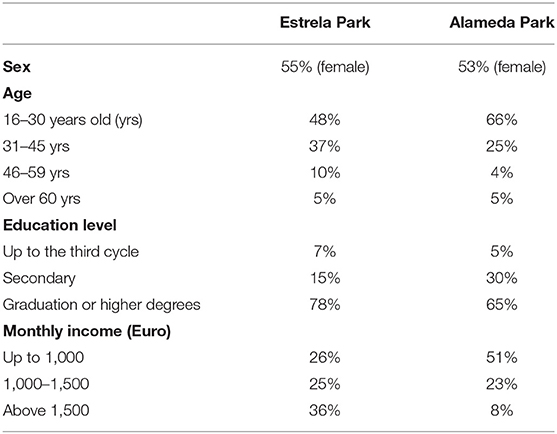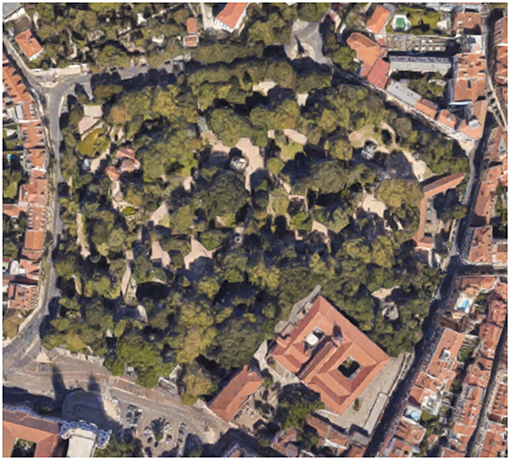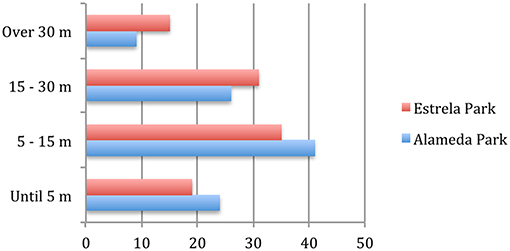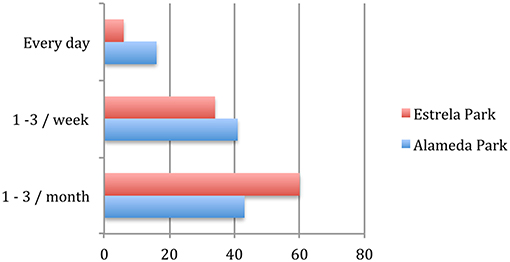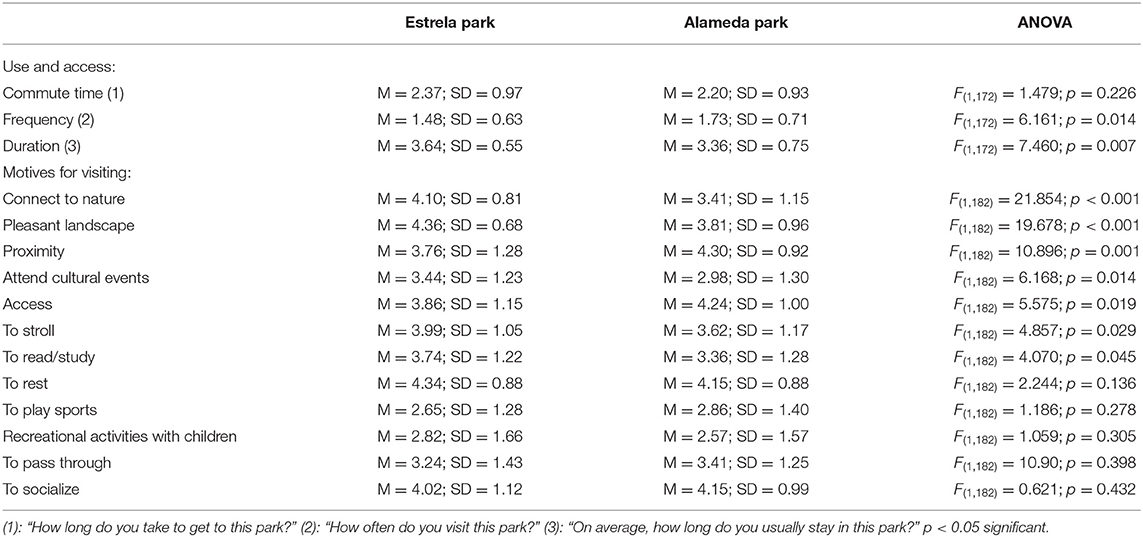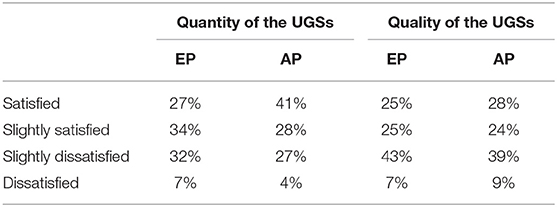- 1Independent Researcher, Lisbon, Portugal
- 2School of Education, Language and Psychology, York St John University, York, United Kingdom
- 3Centro de Investigação e Intervenção Social (CIS-Iscte, ISCTE-IUL), Lisbon, Portugal
Urban Green Spaces (UGSs) play a key role in people's well-being, particularly in highly urbanized contexts and possess several elements that may be attractive to visitors. This study focuses on the views and perceptions of visitors of two UGSs located in Lisbon and aimed to determine how they evaluated two different green spaces (Estrela Park and Alameda Park) in terms of physical/natural characteristics, structures, accessibility, surrounding areas, motives for use and importance. Secondly, it sought to explore how people evaluate UGSs in Lisbon in terms of quality and quantity. A total of 188 people responded to a questionnaire composed of close-and open-ended questions. The study revealed that Estrela Park was more valued for its green space characteristics and conservation aspects than accessibility and sports adaptability. Participants visited Estrela Park for its landscape and restful environment and considered the park important to their lives. Although they visited Estrela Park less often, they stayed longer compared to those who visited Alameda Park. Furthermore, regarding the participants' overall perceptions of the UGSs in Lisbon, many participants mentioned the need for more parks and wanted better preservation and distribution around the city. Most importantly, they valued these spaces and believed that UGS helped them to feel more relaxed and balanced, facilitating socialization, recreation and physical activities. In conclusion, this study suggests that green and quiet urban parks in Lisbon are valued by the city's population but they would like to see regular maintenance/cleaning as well as the provision of leisure activities.
Introduction
Increased urbanization has led to a decline in the quality of the urban environment, particularly in larger towns and cities, affecting people's quality of life (Saldiva, 2018). The city of Lisbon in Portugal is no exception as in recent years the city has grown, incorporating many more new constructions and commercial settings around the center and riverside areas. Due to these new structures as well as the irregular topography that characterizes some of these areas, the wind speed has reduced throughout the city. Consequently, an efficient way to remove pollutants and control thermal comfort has been lost (Lopes et al., 2011), with an increase in new as well as the intensification of heat islands. There is evidence that heat islands occur mostly because of dark and/or asphaltic surfaces (e.g., streets or buildings) that absorb solar radiation and accumulate heat (Pacheco-Torgal, 2015). Besides, when local air is concentrated with pollutant gases, the heat island effect is boosted. In Lisbon, the pollution is associated with vehicle emissions that also aggravate the local ambient noise and air conditioning in commercial and residential areas (Câmara Municipal de Lisboa, 2015). Hence, the quality of life and well-being (WB) of the people in the city has been affected and notably a better and greener scenario is desirable, particularly a more attractive central area with accessible green spaces.
Several studies have shown the benefits of integrating nature in urban settings for both restoration and balance of the urban environment as well as improving people's quality of life (e.g., Li et al., 2010, 2012). Urban Green Spaces (UGS) serve as places for leisure, social interaction and recreation/physical activity (Sá, 2013; Silva, 2016). As health is “a state of complete physical, mental and social well-being and not merely the absence of disease or infirmity” (World Health Organization, 2020, p. 1), the assessment of accessible and attractive green spaces is an integral part of the quality of urban life (Herzele and Wiedemann, 2003). Past studies have shown that the perception of abandoned or vandalized green space can have negative effects on the WB of populations, increasing for example the anxiety caused by the fear of crime (Hoffimann et al., 2017).
For a better understanding of the benefits linking green space and health, Markevych et al. (2017) designed a model that emphasizes three general functions of green spaces: reducing harm (e.g., reducing exposure to air pollution, heat and noise), restoring capacities (e.g., attention restoration and physiological stress recovery) and building capacities (e.g., encouraging physical activity and facilitating social cohesion). Each of these domains influences one or more specific pathways in the other domains and together encompass the four general pathways that have tested their relative contributions as mediators of the relationship between green spaces and health (Markevych et al., 2017). According to the first domain, the presence of nature (mainly trees) helps to purify the air, drain water and control local temperature (Nowak et al., 2014; Heaviside et al., 2017), with trees also helping to reduce urban noise (Margaritis and Kang, 2017). In a study by Nordh and Østby (2013), participants reported lower ratings on psychological restoration likelihood for park scenarios located near a busy street (e.g., parks potentially exposed to high levels of road traffic). Likewise, walking near urban parks decreased negative effects in healthy young adults compared to those who walked along roads in medium-density urban developments (Hartig et al., 2003). In addition, blue elements (e.g., lakes) or even a water fountain also improve the quality of the UGS environment, providing visual and audio respite for city dwellers (Mishra et al., 2020) and creating a better environment for those who visit and/or live nearby a green space.
Regarding the second domain “restoring capacities,” many scholars, particularly from the environmental psychology field, have emphasized that the linkage between exposure and even visual contact to nature may enhance general mental psychological functions (Kaplan and Talbot, 1983; Ulrich et al., 1991; Kaplan, 1995; Olszewska-Guizzo et al., 2020; Sia et al., 2020). Beil and Hanes (2013) exposed participants to different urban settings ranging from very built up to very green (e.g., UGS), confirming that greener spaces reduced stress levels. Besides, improved access to water bodies (blue spaces) has also been linked to enhanced mental WB in city dwellers (Völker and Kistemann, 2015).
According to the third domain, “building capacities,” the mere existence of green spaces encourages people to go out and participate in social or physical activities that are linked with a better quality of life (Santana et al., 2012), especially among older people, emphasizing the tendency that older people live or feel more alone (Kuo et al., 1998; Zhang et al., 2019). Moreover, the offer of features such as physical equipment, cafeteria/restaurants and playgrounds attract visitors to such places (Sá, 2013). Furthermore, as emphasized by Nordh et al. (2009), even small urban parks can predict the possibility of restoration depending only on how they are designed, affirming that the percentage of ground surface covered by grass, the amount of trees and bushes visible from the given viewing point, and apparent park size are most predictive of likelihood of restoration (Nordh et al., 2009).
Taken together, it is evident that each city faces challenges in terms of providing accessible and attractive green spaces for the population. Based on the city center context, our study aimed to understand what characteristics of green spaces are most appreciated by the population and what value they attribute to these UGS. This study aimed (1) to describe and compare how people evaluate two different UGSs located in Lisbon as to physical/natural characteristics, structures, accessibility, surrounding areas, motives for use and importance and (2) to explore how people evaluate UGSs in Lisbon in terms of quality and quantity. To achieve these goals, this study focused on the reported views and perceptions of visitors to two green parks located in Lisbon, Estrela and Alameda Dom Afonso Henriques. These city center parks have different general characteristics but are well-known and visited by many people. The features were assessed in loco (at each park) and on the Lisbon City Council website1, with an emphasis placed on the following aspects/features: size (total acreage), presence of natural elements (e.g., the concentration of trees, green areas, bodies of water), amenities (e.g., kiosk, benches, playground) and accessibility. Park surroundings (e.g., proximity to streets) was also considered and assessed in loco and through satellite images (via Google Earth) to evaluate the proximity to the main streets and buildings/commercial areas around the parks. The survey was conducted in-situ by the first author via paper-based questionnaires that contained four closed-ended questions regarding the use and characterization of the parks and three open-ended questions related to the level of satisfaction and well-being associations regarding the quantity and quality of UGS in Lisbon.
We believe that our exploratory approach will contribute to a better understanding of the UGS features most valued by the visitors of the parks, therefore help to provide better management of those places and surrounding public spaces (non-green spaces).
Materials and Methods
Sample Characterization
A total of 188 people (97 visitors to Estrela Park and 91 visitors to Alameda Park) completed the questionnaire in July and August 2019. There were no significant differences between groups regarding gender (X2(1, 188) = 0.106, p = 0.745), with most participants being female (~55%) and nationality (X2(18, 187) = 21.577, p = 0.251), with the majority of the participants being Portuguese, followed by Brazilians and other nationalities. The average age of the participants was 32.74 ± 12.201 years, with a non-significant difference between the two groups (F(1, 187) = 3.540, p = 0.061). As to their educational background, participants in the Estrela Park group had significantly higher education levels (X2(4, 188) = 17.193, p = 0.002) and income2 ( = 25.962, p < 0.001) compared to their Alameda Park counterparts (see Table 1 below).
Characterization of Urban Green Spaces
Location
Both green parks are located in central Lisbon, in the Territorial Intervention Units (TIU) named “Center” and “Historic Center,” respectively indicated by the numbers “1” and “2” in Figure 1 below (Câmara Municipal de Lisboa, 2015).
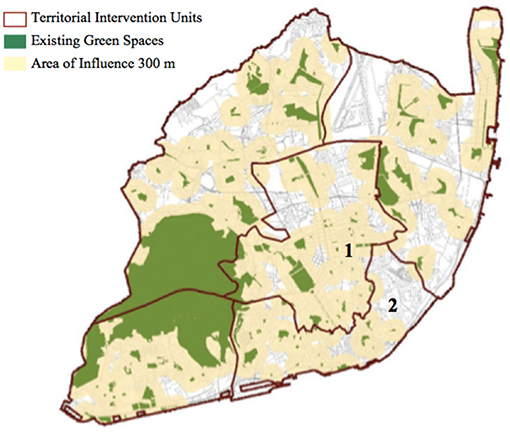
Figure 1. Territorial intervention units of Lisbon. Source: (Câmara Municipal de Lisboa, 2015), p. 44, with adaptation.
UGSs in this map are represented with an influence radius of 300 meters (m), which is the minimum radius of influence classification given to green spaces and does not always correspond to their potential, for example, due to the difficulty of access. According to the Lisbon Spatial Planning Report (SPR/REOT), “Príncipe Real” park serves only 47% of the population (Câmara Municipal de Lisboa, 2015 p. 43). Overall, there are some areas in TIU's “1” and “2” that do not have any UGSs. The green parks selected for our study are characterized as local green spaces and their location, as well as their area of influence (500 m), is represented in Figure 2 below (Câmara Municipal de Lisboa, 2015).
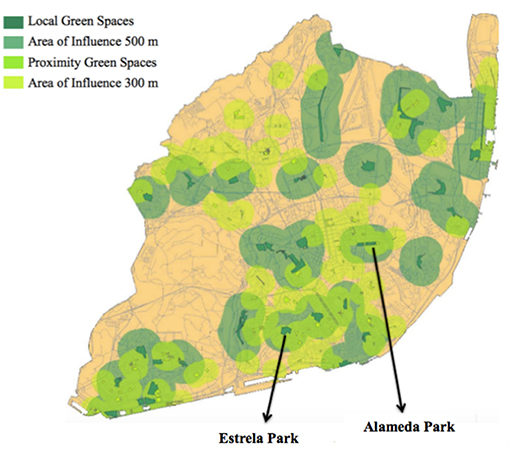
Figure 2. Green parks location in Lisbon. Source: (Câmara Municipal de Lisboa, 2015), p. 42, with adaptation.
The commute time between each park is ~14 min by car, 25 min by bus and a 50 min walk.
Estrela Park
This park covers 4.5 hectares and is easily accessed by both bus and tram (Câmara Municipal de Lisboa, 2015). On a physical level, the area is fenced and the park is characterized by one big leafy area with diverse vegetation and a lake with fish, water birds and ducks. On a structural level, there are a few walking paths with several seating benches, a kiosk with a terrace, a restaurant, a bandstand, statuary, as well as two recreational areas, one for children and families including a playground, and a sports court. There is also gym equipment. The area surrounding the park is characterized by a large avenue, as well as a few residential buildings, as shown in the figure of the park from above (Figure 3).
Alameda Park
Alameda Park (Figure 4) covers 3.3 hectares and is well-served by public transport, including several buses and a metro station (Câmara Municipal de Lisboa, 2015). One side is separated by a large avenue (Avenue Almirante Reis) and on the other side is by a regular street, which makes this a park of three large linear green areas. The extreme areas are sloping, one is just grassy and green and the other covers a few trees with a large viewpoint over the city center. The middle area is flat grass, with a wide sidewalk with a few more trees on both sides of the park. Structurally, it has a large fountain (dating from 1940) in the sloping area with the viewpoint at the top and a few scattered benches. It also has a children's playground, a kiosk with a terrace and some gym equipment. The park's surroundings consist of a few commercial stores (e.g., bars, coffee shops and mini markets) and some residential buildings. The Higher Technical Institute of Lisbon3 that is today the largest engineering, architecture, science, and technology school in Portugal is nearby.
Measures and Procedures
A questionnaire was used to analyse the views and perceptions of the two UGS' visitors. Due to the significant number of foreign residents in Lisbon, particularly in the areas where the parks are located (Afonso et al., 2016), Portuguese and English versions of the questionnaire were prepared. ~25 people per park completed the English version and when available, the Portuguese version of the items was used. Written informed consent for participation was required for this study and all participants signed an informed consent form before completing the questionnaire.
Data collection was conducted between July and August 2019. The first author approached potential participants in both parks during the morning and afternoon on alternating days, aiming for a study sample balanced in terms of gender and diverse in terms of age. Before completing the questionnaire, the participants were required to have visited the park at least three times in the previous 2 months. In most cases, participants completed the questionnaire by themselves, although some people (notably elderly ones) asked for the researcher's help, taking ~15–25 min to complete the questionnaire.
The original questionnaire comprised eight dimensions (Viebrantz, 2019; see Supplementary Material), for this we considered only five: characterization of use and access, motives for visiting, characterization of the parks and their importance. Moreover, three open questions regarding the level of satisfaction and association of well-being with UGS in Lisbon were included. The response scale for all items, except for characterization of use and access, was based on a Likert scale ranging from “1” to “5,” with “5” being the highest attractiveness/agreement score.
Characterization of Use and Access
Questions in this dimension were based on the studies by Sá (2013) and Silva (2016). The first question, “How do you usually get to this park?” included four response options (“on foot,” “by bus,” “by car” and “by metro”) and an additional “other” option, considering the residential distance. The second question, “How long do you take to get to this park?” included four response options ranging from “1–5 min” to “over 30 min.” The third question, “How often do you visit this park?” included three response options ranging from “every day” to “1–3 times a month.” Finally, participants were asked “On average, how long do you usually stay in this park?,” which included four response options ranging from “15 min” to “1–2 h.” It is worth mentioning that participants were asked to respond according to their place of residence.
Motives for Visiting
This dimension involved 13 items based on the studies by Sá (2013) and Silva (2016) (e.g., to rest; to play sports; to appreciate nature), with one item introduced as “other motive.”
Characterization of the Park
A total of 15 items were used to evaluate visitors' perceptions concerning the park's characteristics (Sá, 2013; Kothencz and Blaschke, 2017). The item “this park is noisy (buses, cars, services)” was recoded for combination with an ascendant scale used for the other items in this dimension. An exploratory factor analysis suggested that these items could be aggregated in three main factors, with reliability analysis indicating good internal consistency: Physical characterization and surroundings (Cronbach's α = 0.80), (e.g., “This park provides sufficient shades,” see items 1–9); F2–Conservation (α = 0.76), (e.g., “The quality of the paved areas in this park is good enough,” see items 10–12); and, F3–Accessibility and Sports adaptability (α = 0.64), (e.g., “This park is very accessible (public transport, by foot),” see items 13–15).
Importance of the Park
Inspired by Kothencz and Blaschke (2017), this dimension was composed of three items (α = 0.76), (e.g., “I like this garden”).
Satisfaction and Well-Being Associations With UGSs
Two open-ended questions were developed by the authors to analyse visitors' satisfaction with the quantity and quality of the UGS in Lisbon: “Overall, how satisfied are you with the quantity of urban green spaces that exist in the city of Lisbon?” and, “How satisfied are you with the quality of those green spaces?” Another question was designed to understand how visitors associate their WB with the UGS: “How do green spaces contribute to your well-being?”.
Data Analysis
Participants' responses to the closed-ended questions were analyzed using the Statistical Package for the Social Sciences (SPSS Statistics, version 28). First, descriptive statistics were performed, then multivariate analysis of variance (MANOVA) to compare groups (Alameda and Estrela Parks) in terms of commute time, frequency of visit, duration, motives for visiting, perceptions of the park's characteristics (physical characterization and surroundings; conservation; accessibility and sports adaptability) and importance of the parks. In line with (Züll, 2016), the open-ended questions were subject to content analysis. To evaluate the participants' satisfaction with the quantity and quality of Lisbon UGS, we focused on the average of the reported level of satisfaction expressed by the participants and the main motives highlighted for their (dis)satisfaction. Furthermore, to examine the type of associations made between the UGSs and well-being, we used the three domains proposed by Markevych et al. (2017), reducing harm, restoring capacities and building capacities to organize the responses. Regarding the reducing harm category, we considered all descriptions of the park about the enhancement of the quality of the environment (and surroundings), including references to air, heat, and noise pollution (Nordh and Østby, 2013; Nowak et al., 2014; Heaviside et al., 2017). For restoring capacities, we included all the responses that mentioned the importance of contact with nature and/or being in nature (Kaplan and Kaplan, 1989; Kaplan, 1995), as well as aspects related to concentration of trees and presence of blue and green surfaces (Beil and Hanes, 2013; Nordh and Østby, 2013; Völker and Kistemann, 2015; Mishra et al., 2020). Parks' facilities and maintenance were also considered here (Silva, 2016). As to building capacities, we considered all the responses regarding social contact and the practice of physical/recreational activities (Kuo et al., 1998; Zhang et al., 2019). Parks' accessibility was also considered here (Herzele and Wiedemann, 2003).
Results
Descriptive Analysis and MANOVA
Use, Access, and Motives
Regarding the characterization of the use and access to the parks, the descriptive analysis showed that at least 60% of participants in both groups usually access the park by foot, followed by a bus (~20%) and car (~11%) at Estrela Park and by metro (~20%) and bus (~8%) at Alameda Park (see Figure 5). Regarding commute time, most participants (~35%) in both groups usually took between “5–15 min” to get to the parks. Overall, however, participants who visited Estrela Park reported longer journeys to get to the park compared to their counterparts at Alameda Park (see Figure 5).
Regarding the frequency of use, most participants in both groups tended to visit the parks between “1–3 times a month,” more frequently for Estrela Park (60% compared to 43% in Alameda Park), with “daily attendance” to the parks the lowest for both groups, although more frequent for visitors to Alameda Park (see Figure 6).
Regarding the time spent in the parks, most visitors tended to stay at least “1–2 h,” followed by “1–15 min,” with visitors spending longer in Estrela Park. Moreover, considering the visitor's place of residence, most lived in the parish where the park is located but ~25% of those who visited Estrela Park also resided in parishes in the vicinity of Alameda Park.
The MANOVA indicated significant differences between the parks in terms of use and access [Pillai' trace = 0.063; F(3, 170) = 3.820; p < 0.05], however, separate univariate ANOVAs (see Table 2) revealed that these differences were not significant for the variable commute time but to the frequency and duration variables. Participants from Estrela Park visited less frequently but stayed for longer compared to the Alameda Park group.
Regarding the motives for visiting, most visited Alameda Park for its “Proximity” (M = 4.30; SD = 0.91), while most participants visited Estrela Park for its “Pleasant landscape” (M = 4.36; SD = 0.68)/“Resting” (M = 4.35; SD = 0.87). Subsequent univariate ANOVAs (see Table 2) indicated that there were significant differences between parks for the following motives: “pleasant landscape,” “connect to nature,” “proximity,” “attend to cultural events,” “access,” “to stroll,” “to read/study,” with participants from Estrela Park presenting higher means except for “proximity” and “access” motives. Table 2 below provides the means, standard deviations (SD) and ANOVAs of the variables that characterize how and why the participants use and access the parks.
Characterization and Importance of the Parks
The MANOVA indicated that there are significant differences between the parks in terms of how participants perceive parks' characteristics [Pillai' trace = 4.97; F(3, 184) = 60.495; p < 0.001]. These differences were significant for the characterization of the park (physical characterization and surroundings; conservation; and, accessibility and sports adaptability), (see Table 3), with participants from Estrela Park scoring higher on the perceived physical characterization and surroundings and conservation but lower for accessibility and sports adaptability. Regarding the importance of the park, there were significant differences between both groups [Pillai' trace = 0.148; F(2, 184) = 15.974; p < 0.001], with Estrela Park visitors scoring their park higher (see Table 3).
Content Analysis: Satisfaction and Well-Being Associations With UGSs
~80% of both Estrela Park and Alameda Park visitors responded to the open-ended questions and the content analysis was organized in two broad categories: perceptions of the Quantity and Quality of the UGSs in Lisbon and associations between the UGSs and well-being, with results presented by the park type.
Perceptions of the Quantity and Quality of the UGSs in Lisbon
Estrela Park (EP) participants seemed to be more slightly satisfied or even slightly dissatisfied with the amount of UGSs in Lisbon than their Alameda Park (AP) counterparts, who in turn seemed to be more satisfied with the number of parks. Regarding the quality of the UGSs, the level of satisfaction between both groups was more similar and the participants seemed to be more slightly dissatisfied with the quality of the UGSs in Lisbon (see Table 4 below).
Estrela Park Participants
Concerning the participants that were completely satisfied with the quantity of the UGSs, some still emphasized that having more UGSs in the city would be great: e.g., “I think the relationship is not bad, but the more green spaces there are, the better.” (J.S. 4, 32 yrs). Additionally, a few mentioned the importance of such places for their lives: “UGS are not enough in my opinion, but they are good “getaways” from the city” (J.B., 36 yrs). Regarding those that were either slightly satisfied or dissatisfied, some highlighted the poor distribution of the existing parks: e.g., “Lisbon UGSs are not enough and should be better distributed” (I.A., 40 yrs), as well as that the UGSs should be prioritized in urban planning: e.g., “[…] I think that instead of making monstrous buildings in the middle of the city, UGSs would be more useful” (B.T., 27 yrs). Consequently, the few participants that were completely dissatisfied mentioned urban pressure effects, e.g., “I feel a lot of urban pressure, in the sense there could be more UGSs in the city.” (R.B., 36 yrs).
Regarding the quality of the UGSs, the elements more frequently mentioned concerned the park condition and the availability of recreational areas, with many participants mentioning the lack of cleaning and poor preservation, e.g., “More could be done. Rubbish is still a problem.” (E.S., 38 yrs). Regarding the recreational areas, the main concerns were their scarcity and the poor upkeep and maintenance of the existing areas, e.g., “I am reasonably satisfied. Some [UGSs] could offer more leisure options and be better maintained.” (E.R., 39 yrs). Besides, a few participants stressed the need for more trees/vegetation, e.g., “I think there could be more UGSs, mainly in the central area, and more trees as well” (M.F., 25 yrs) and “They (UGS) could be better preserved and have more vegetation” (A.P., 37 yrs). Moreover, the ease of access was also mentioned, e.g., “I think Lisbon needs more UGSs and with easier access” (G.V., 33 yrs). While some were not very specific about the type of changes they would like to see implemented, a few participants mentioned that they are aware of the progress to date, “There is a growing awareness regarding UGS, but we still have a lot to improve” (A.C., 43 yrs).
Alameda Park Participants
Although this group was more satisfied with the amount of UGSs in Lisbon than their Estrela Park counterparts, they held similar views regarding the distribution and amount, e.g., “Satisfied, but I think that more sites could be rehabilitated to create green spaces.” (N.T., 24 yrs) and “I am slightly satisfied, but even more would always be welcome!” (A.C, 32 yrs). The participants that were slightly dissatisfied or even completely dissatisfied mentioned mostly concerns about the city environment related to the lack of UGSs, e.g., “Slightly dissatisfied. In the summer it is torture to cross any of the main squares in the city, especially in the central area Baixa” (J.J., 31 yrs).
Regarding the quality of the UGSs, participants also hold concerns regarding the park condition and the scarcity of recreational areas, with more emphasis on the lack of vegetation, e.g., “There should be more activities and structures for children. It has little shade and little variety of fauna and flora. Trees, shrubs, biodiversity are missing” (J.V., 34 yrs). Additionally, regarding the UGS size and the concentration of trees, “For a city like Lisbon, the number of UGSs is sufficient, but it is not optimal. They could be larger and have more trees” (M.C., 41 yrs). Regarding UGS preservation, the major difference mentioned in this group is a lack of civility from the public and the lack of bins, e.g., “UGS could be better (preserved) but people don't contribute much either. There are many butts and garbage on the grass” (S.C., 27 yrs) and “People do not collaborate much with the preservation of these spaces, which is a pity” (N.F., 31 yrs). Besides, it was mentioned that the issues regarding the park condition might not be the same in each UGS, “The quality of the UGSs varies according to the space. Some are well-preserved” (R.B., 33 yrs old). Moreover, noise issues regarding the city environment were also mentioned by a few, “There is a lack of bins in the city and the UGS, with only a few dustbins and ashtrays and too many cars causing too much noise” (A.B., 46 yrs).
Associations Between the UGSs and Well-Being
Regarding the associations between the UGSs and well-being, the domains restoring capabilities and building capabilities were the most emphasized in both groups and reducing harm aspects were commonly mentioned among both groups.
Estrela Park Participants
Participants of this park seemed to value the calmness and the benefits of the contact with nature that the UGSs provide, e.g., “Green spaces are very important to relax, rest, breathe, get sunlight” (A., 35 yrs), “I need the contact with the green (nature) to keep me balanced” (J.P., 42 yrs) and “They are essential, offering me tranquility due to nature and escape from the city's climate” (C.P., 31 yrs). Furthermore, participants seemed to benefit from the social interactions in the UGSs, “It contributes as a good place for meeting and socializing with friends and for individual relaxation” (A.P., 37 yrs) and “[…] being surrounded by people (even strangers), contemplating nature … makes me feel very good” (J.A, 27 yrs). In addition, participants seem to enjoy spending family time at the UGSs, attributing much value to those that have recreational/leisure areas for children, “Going to the park is a daily contribution to my well-being and they are very important to me, mainly for playing with my children” (M.L., 35 yrs) and “I like to walk and play with my children in these spaces” (M.C., 41 yrs). Moreover, UGSs were seen to contribute to participants' practice of physical activities, “I can train (sport) outdoors and breathe better, relax too” (J.A., 35 yrs) and to help to improve the quality of the city environment, “They are very important to reduce the noise and pollution of a city” (A.M., 29 yrs). Overall, UGSs seem to play an important role in participants' lives, “They are essential for me to escape the city confusion. I need nature and the parks here in Lisbon are the closest to it” (J.B., 36 yrs). Besides the benefits of the UGSs, a few participants mentioned having concerns regarding the unsuitable surroundings of a few parks, “The issue of noise in these spaces is something that affects me a lot and I don't think its something taken into account in their creation/organization (J.H., 35 yrs old).
Alameda Park Participants
Participants of this park also seemed to value and perceive benefit from the contact with nature in the UGSs, on improving their social relationships and having a place to practice sports outdoor. In addition, some examples regarding time spent in the UGSs and contact with nature, “They (UGS) provide me a way to calm down, distract and relax” (J.F., 34 yrs), “Contact with nature helps me to relax and to feel more active” (I.M., 36 yrs) and “The parks promote authentic contact with nature, which makes me feel good. Therefore, they are essential in the city!” (C.A., 29 yrs). Additionally, they mentioned other activities such as strolling with the dog, e.g., “These are spaces where I am happy with my dog, where I can stop for a while after a busy day and remember the simple and good things that really matter and make me happy” (A.C., 23 yrs). Regarding socialization, UGSs seemed to improve participants' social relations and times spent with their families, also in an interspersed way, “The green spaces have helped me to build a good relationship with a friend” (M.V., 33 yrs), “I spend much of my free time in parks, with friends. It contributes a lot to my social life” (A.S., 28 yrs) and “As I am between jobs at the moment, I use them daily; they are great for doing exercise and being with my son” (P.R., 33 yrs). Finally, visitors mentioned aspects concerning the park environment, “I like to breathe fresh air while enjoying a good walk and the landscape” (C.B., 30 yrs) and “They contribute immensely, the more integrated vegetation in the city, the greater the quality of life” (N.S., 40 yrs). The UGS seemed to improve people's lives in many ways, e.g., “Without nature we are nothing! It contributes in all ways. From sightseeing, mental refuge, “meeting point,” everything!” (N.F., 31 yrs). Besides the benefits of the UGSs, a few participants also mentioned having concerns regarding the unsuitable surroundings of a few parks, “The few (UGSs) that exist are surrounded by confusion and noise. It is impossible to relax fully, but it is good that they exist” (C.V., 29 yrs).
Discussion
This study focused on the perceptions of the Alameda and Estrela Parks' characteristics, motives for use, accessibility, and importance to people's lives. Moreover, it also described how a sample of inhabitants evaluated existing UGSs in Lisbon in terms of quantity and quality and associate their well-being with these UGSs. Our findings indicated that Estrela Park compared to Alameda Park was significantly better evaluated regarding the parks physical/natural characteristics, surroundings, and conservation aspects but not regarding its accessibility and sports adaptability. When looking at the physical characteristics via satellite images, it was possible to see that Estrela Park is indeed mostly covered by trees and vegetation, while Alameda Park is more a green flat area. Besides, this park presents many more natural elements such as a lake and even wild animals compared to Alameda Park, suggesting that Estrela Park is better characterized as a green and natural park. Moreover, the park has more trees which help to reduce urban noise (Margaritis and Kang, 2017) and is not as close to the surroundings streets compared to Alameda Park, therefore provides a much quieter environment. Alameda Park is divided by several streets, so may be noisier with poorer air quality due to the vehicles that pass compared to Estrela Park. Regarding the park structures, Estrela Park has many more features than Alameda Park (e.g., benches, restaurant, playground), offering more leisure options to people. Furthermore, regarding the park's sports adaptability, there were no significant differences between parks even though Estrela Park has a sports court. Finally, regarding the accessibility of the park, Alameda Park can be accessed by many different means of transport compared to Estrela Park, hence there is better access to this park than to Estrela Park.
Regarding the motives of participants visiting the parks, it was not surprising that “pleasant landscape” and “rest” were the most valued by visitors to Estrela Park. Indeed, “pleasant landscape” and “connect to nature” were the motives that better described the differences between both groups, with “proximity” better describing the motivation to visit Alameda Park, indicating that the existence of the park is already relevant for some visitors. A large proportion of visitors to Estrela Park (~25%) lived in parishes closer to Alameda Park but they were not motivated to visit due to the access to Estrela Park as it did not score highly, suggesting that visitors place a higher premium on other aspects of UGSs. Furthermore, although participants visited Estrela Park less often, they tended to spend longer in the park, which does not seem to be related to the commute time but to the park's characteristics. Additionally, our findings suggest that visitors to Estrela Park also attribute more importance to the UGS compared to visitors to Alameda Park.
In line with previous literature (Beil and Hanes, 2013; Völker and Kistemann, 2015), these findings suggest that people particularly value the landscape and the contact with nature when visiting Estrela Park. Moreover, as the presence of nature (mainly trees) helps to purify the air and control local temperature (Nowak et al., 2014; Heaviside et al., 2017), the Estrela Park environment might be indeed more attractive to visitors. Also, Estrela Park seemed to be quieter than Alameda Park, which may explain why some participants, particularly those living close to Alameda Park, choose to visit Estrela Park even though it was further away (Hartig et al., 2003; Margaritis and Kang, 2017). Overall, these findings seemed to be aligned with Nordh et al. (2009) study and to Santana et al. (2012) and Sá (2013), due to the availability of its structures and recreational features.
Although all participants were generally satisfied with the quantity of UGS in Lisbon, they would appreciate more parks in the city, as many of them mentioned to value the natural features (e.g., presence of trees) of the UGSs, making them feel more relaxed, in line with Beil and Hanes study (2013). Besides, breathing fresh air or simply enjoying the view seemed to contribute to visitors' well-being (Nordh and Østby, 2013; Nowak et al., 2014; Heaviside et al., 2017), with participants reporting feeling stressed when exposed to a few UGSs surrounded by traffic noise. Nonetheless, participants also suggested benefitting from the time spent with their friends and relatives in such places, as well as practicing physical activities, which aligns with previous literature (Kuo et al., 1998; Santana et al., 2012). It was also mentioned that the UGSs offer more than one or two benefits to the visitors, which supports the importance of looking at diverse dimensions and how each domain relates and complements one another (Markevych et al., 2017). As a cross-functional view of these places was recognized, the UGSs seemed to be important for peoples' lives and their well-being. Taken together, the fact that people can have a place to be outdoors seems to be most important.
Study Limitations
This study had some limitations. First, by virtue of responding first to close-ended questions, participants were invited to consider a set of specific elements/aspects, which may have influenced their response to the open-ended questions. Also, a Portuguese and an English version of the questionnaire was available, allowing the recruitment of participants of different nationalities but this may have influenced their interpretations of the questions. Future studies should therefore consider using qualitative approaches (e.g., in-depth interview) to better understand how people feel and perceive the UGSs they visit more often. Secondly, during data collection, some visitors were more difficult to reach than others, for example, those who were exercising or the elderly. In both parks, it was common to see people playing team sports (e.g., football) or individually (e.g., running) in groups. In this sense, future studies should explore the motives for visiting UGSs from a more comprehensive approach, including for example observational notes. Thus, our results allowed us to explore the perceptions of a diverse group of visitors but provided little detail on the specificities and needs of each group of visitors. Further research should seek to explore how different groups perceive each UGS.
Conclusion
This study contributes to a better understanding of how people perceive UGS in Lisbon, as well as the UGS characteristics considered attractive, suggesting that they could be better designed taking into consideration: physical/natural elements, by providing more trees/bushes/green areas; the surrounding conditions, by keeping a greater distance from major avenues and traffic noise and choosing to rehabilitate abandoned sites; and structures, by improving the leisure options for both: children and adults. Furthermore, as participants were concerned about the poor maintenance and preservation of the existing UGS, public authorities responsible for UGS management should increase the frequency of cleaning and maintenance and provide more waste bins. In addition, similar improvements could be made to non-green public spaces, such as tree installations, for example, as the ease of access to some of these UGS—notably in the center—is not always favorable. Moreover, the study showed that UGS are an important way to escape the city's clutter/pollution/stress and for this reason, future studies should seek to understand the link between health and UGS taking into account moderating factors, such as income level and education.
Data Availability Statement
The data that support the findings of this study are available on request from the corresponding author Petra Viebrantz. The data are not publicly available due to their containing information that could compromise the privacy of research participants.
Ethics Statement
Ethical review and approval was not required for the study on human participants in accordance with the local legislation and institutional requirements. Written informed consent for participation was not provided by the participants' legal guardians/next of kin because the person under 18 declared to be consent about it.
Author Contributions
PV was responsible for creating and writing each section of the paper, making the data collection, and statistical procedures. MF-J contributed with data analyses and the study discussion. Both authors contributed to the article and approved the submitted version.
Conflict of Interest
The authors declare that the research was conducted in the absence of any commercial or financial relationships that could be construed as a potential conflict of interest.
Publisher's Note
All claims expressed in this article are solely those of the authors and do not necessarily represent those of their affiliated organizations, or those of the publisher, the editors and the reviewers. Any product that may be evaluated in this article, or claim that may be made by its manufacturer, is not guaranteed or endorsed by the publisher.
Acknowledgments
The content of this paper is based on the master's thesis in Environmental Studies and Sustainability, in ISCTE, of the first author, entitled: Perceção dos utilizadores dos jardins da Alameda e da Estrela: Associação das características dos jardins no bem-estar e na qualidade de vida (Viebrantz, 2019). We thank all the participants that have contributed to this research.
Supplementary Material
The Supplementary Material for this article can be found online at: https://www.frontiersin.org/articles/10.3389/frsc.2021.755423/full#supplementary-material
Abbreviations
UGS, Urban Green Spaces; WB, Well-being; Meters, m; Hours, h; Minutes, m.
Footnotes
1. ^https://visitar.lisboa.pt/explorar/locais-de-interesse/cat/jardins-parques-urbanos (accessed April 12, 2021).
2. ^According to the Lisbon Trade Union, the average salary in the district of Lisbon in 2019 was 1,171.9 euros, but 17,7% of workers received <600 euros and 29.2% earned between 600 and 900 euros. https://eco.sapo.pt/2019/11/22/salario-medio-em-lisboa-e-mais-de-mil-euros/ (accessed May 19, 2021).
3. ^https://tecnico.ulisboa.pt/pt/ (accessed June 14, 2021).
4. ^The names are fictitious for identification purposes.
References
Afonso, J. C., Valadas, R., Cintra, S., Fitas, M.-F., and Saldida, I. (2016). Data from: Rede Social de Lisboa: II Diagnóstico Social de Lisboa: 2015–2016. Assembléia Municipal de Lisboa Repository.
Beil, K., and Hanes, D. (2013). The influence of urban natural and built environments on physiological and psychological measures of stress: a pilot study. Int. J. Environ. Res. Public Health 10, 1250–1267. doi: 10.3390/ijerph10041250
Câmara Municipal de Lisboa (2015). Relatório do Estado de Ordenamento do Território (Reot). Câmara Municipal de Lisboa.
Hartig, T., Evans, G., Jamner, L., Davis, D., and Gärling, T. (2003). Tracking restoration in natural and urban field settings. J. Environ. Psychol. 23, 109–123. doi: 10.1016/S0272-4944(02)00109-3
Heaviside, C., Macintyre, H., and Vardoulakis, S. (2017). The urban heat island: implications for health in a changing environment. Curr. Environ. Health Rep. 4, 296–305. doi: 10.1007/s40572-017-0150-3
Herzele, A., and Wiedemann, T. (2003). A monitoring tool for provision of accessible and attractive urban green spaces. Landsc Urban Plan. 63, 109–126. doi: 10.1016/S0169-2046(02)00192-5
Hoffimann, E., Barros, H., and Ribeiro, A. (2017). Socioeconomic inequalities in green space quality and accessibility: evidence from a southern European city. Int. J. Environ. Res. Public Health 14:916. doi: 10.3390/ijerph14080916
Kaplan, R., and Kaplan, S. (1989). The experience of nature: A psycho perspec. Cambridge University Press.
Kaplan, S. (1995). The restorative benefits of nature: toward an integrative framework. J. Environ. Psychol. 15, 169–182. doi: 10.1016/0272-4944(95)90001-2
Kaplan, S., and Talbot, J. (1983). “Psychological benefits of a wilderness experience,” in Behavior and the Natural Environment, eds I. Altman, and J. F. Wohlwill (New York, NY: Plenum), 163–203. doi: 10.1007/978-1-4613-3539-9_6
Kothencz, G., and Blaschke, T. (2017). Urban parks: visitor's perceptions vs. spatial indicators. Land Use Policy 64, 233–244. doi: 10.1016/j.landusepol.2017.02.012
Kuo, F., Sullivan, W., Coley, R., and Brunson, L. (1998). Fertile ground for community: inner-city neighbourhood common spaces. Am. J. Community Psychol. 26, 823–851. doi: 10.1023/A:1022294028903
Li, H., Chau, C., and Tang, S. (2010). Can surrounding greenery reduce noise annoyance at home? Sci. Total Environ. 408, 4376–4384. doi: 10.1016/j.scitotenv.2010.06.025
Li, H., Chau, C., Tse, M., and Tang, S. (2012). On the study of the effects of sea views, greenery views and personal characteristics on noise annoyance perception at homes. J. Acoust. Soc. Am. 131, 2131–2140. doi: 10.1121/1.3681936
Lopes, A., Saraiva, J., and Alcoforado, M. J. (2011). Urban boundary layer wind speed reduction in summer due to urban growth and environmental consequences in Lisbon. Environ. Model. Softw. 26, 241–243. doi: 10.1016/j.envsoft.2010.05.015
Margaritis, E., and Kang, J. (2017). Relationship between green space-related morphology and noise pollution. Ecol. Indic. 72, 921–933. doi: 10.1016/j.ecolind.2016.09.032
Markevych, I., Schoierer, J., Hartig, T., Chudnovsky, A., Hystad, P., Dzhambov, A., et al. (2017). Exploring pathways linking greenspace to health: theoretical and methodological guidance. Environ. Res. 158, 301–317. doi: 10.1016/j.envres.2017.06.028
Mishra, H., Bell, S., Vassiljev, P., Kuhlmann, F., Niin, G., and Grellier, J. (2020). The development of a tool for assessing the environmental qualities of urban blue spaces. Urban For. Urban Green. 49, 1–11. doi: 10.1016/j.ufug.2019.126575
Nordh, H., Hartig, T., Hagerhall, C. M., and Fry, G. (2009). Components of small urban parks predict the possibility for restoration. Urban For. Urban Green. 8, 225–235. doi: 10.1016/j.ufug.2009.06.003
Nordh, H., and Østby, K. (2013). Pocket parks for people–a study of park design and use. Urban For. Urban Green. 12, 12–17. doi: 10.1016/j.ufug.2012.11.003
Nowak, D., Hirabayashi, S., Bodine, A., and Greenfield, E. (2014). Tree and forest effects on air quality and human health in the United States. Environ. Pollut. 193, 119–129. doi: 10.1016/j.envpol.2014.05.028
Olszewska-Guizzo, A., Sia, A., Fogel, A., and Ho, R. (2020). Can exposure to certain urban green spaces trigger frontal alpha asymmetry in the brain?—Preliminary findings from a passive task EEG study. Int. J. Environ. Res. Public Health 17:394. doi: 10.3390/ijerph17020394
Pacheco-Torgal, F. (2015). Introduction to eco-efficient materials to mitigate building cooling needs. Eco-efficient materials for mitigating building cooling needs. Des. Prop. Appl. 1:9. doi: 10.1016/B.978-1-78242-380-5.00001-7
Sá, J. (2013). Espaços verdes em meio urbano: uma abordagem metodológica com base em serviços de ecossistema (Master's thesis). Instituto Técnico de Lisboa. Lisbon, Portugal.
Saldiva, P. (2018). Vida urbana e saúde: Os desafios dos habitantes das metrópoles. São Paulo: Editora Contexto.
Santana, P., Nogueira, H., Santos, R., and Costa, C. (2012). Avaliação da qualidade ambiental dos espaços verdes urbanos no bem-estar e na saúde das populações. Planeamento Urbano Saudável. Desenvolvimento e aplicação de um modelo ao caso da Amadora project. Health Geography Research Group.
Sia, A., Tam, W. W., Fogel, A., Kua, E. H., Khoo, K., and Ho, R. C. (2020). Nature-based activities improve the well-being of older adults. Sci. Rep. 10, 1–8. doi: 10.1038/s41598-020-74828-w
Silva, G. (2016). Avaliação da disponibilidade de espaços verdes públicos no contexto urbano e a sua relação com a perceção dos residentes: Um estudo para a cidade de Bragança (Master's thesis). Instituto Politécnico de Brangança, Bragança, Portugal.
Ulrich, R., Simon, R., Losito, B., Fiorito, E., Miles, M., and Zelson, M. (1991). Stress recovery during exposure to natural and urban environments. J. Environ. Psychol. 11, 201–230. doi: 10.1016/S0272-4944(05)80184-7
Viebrantz, P. (2019). Perceção dos utilizadores dos jardins da Alameda e da Estrela: associação das características dos jardins no bem-estar e na qualidade de vida (Master's thesis). Instituto Universitário de Lisboa (ISCTE), Lisbon, Portugal.
Völker, S., and Kistemann, T. (2015). Developing the urban blue: comparative health responses to blue and green urban open spaces in Germany. Health Place 35, 196–205. doi: 10.1016/j.healthplace.2014.10.015
Zhang, C., Barnett, A., Johnston, J., Lai, P.-C., Lee, R., Sit, C., and Cerin, E. (2019). Objectively-measured neighbourhood attributes as correlates and moderators of quality of life in older adults with different living arrangements: the ALECS cross-sectional study. Int. J. Environ. Res. Public Health. 16:876. doi: 10.3390/ijerph16050876
Keywords: urbanization, people-environment, urban green spaces, Lisbon, park's characterization
Citation: Viebrantz P and Fernandes-Jesus M (2021) Visitors' Perceptions of Urban Green Spaces: A Study of Lisbon's Alameda and Estrela Parks. Front. Sustain. Cities 3:755423. doi: 10.3389/frsc.2021.755423
Received: 08 August 2021; Accepted: 13 October 2021;
Published: 18 November 2021.
Edited by:
Diogo Guedes Vidal, Fernando Pessoa Energy, Environment and Health Research Unit (FP-ENAS), PortugalReviewed by:
Agnieszka Anna Olszewska-Guizzo, National University of Singapore, SingaporeAndré Samora-Arvela, New University of Lisbon, Portugal
Copyright © 2021 Viebrantz and Fernandes-Jesus. This is an open-access article distributed under the terms of the Creative Commons Attribution License (CC BY). The use, distribution or reproduction in other forums is permitted, provided the original author(s) and the copyright owner(s) are credited and that the original publication in this journal is cited, in accordance with accepted academic practice. No use, distribution or reproduction is permitted which does not comply with these terms.
*Correspondence: Petra Viebrantz, cGV0cmF2aWVicmFudHpAZ21haWwuY29t
 Petra Viebrantz
Petra Viebrantz Maria Fernandes-Jesus
Maria Fernandes-Jesus